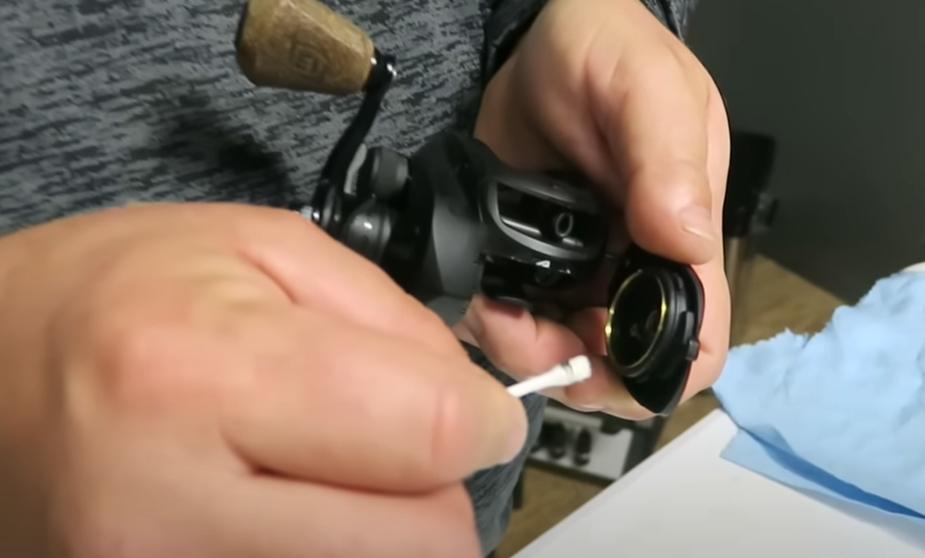Clean a baitcasting reel by first disassembling it and then using isopropyl alcohol and a soft brush to gently scrub each part. Re-lubricate all moving parts before reassembling the reel.
Maintaining your baitcasting reel is crucial to ensure its longevity and optimal performance. Seasoned anglers know that a clean reel can mean the difference between a successful day on the water and a frustrating one. Dirt, grime, and saltwater can corrode parts and hinder a reel’s function, making regular cleaning a necessity.
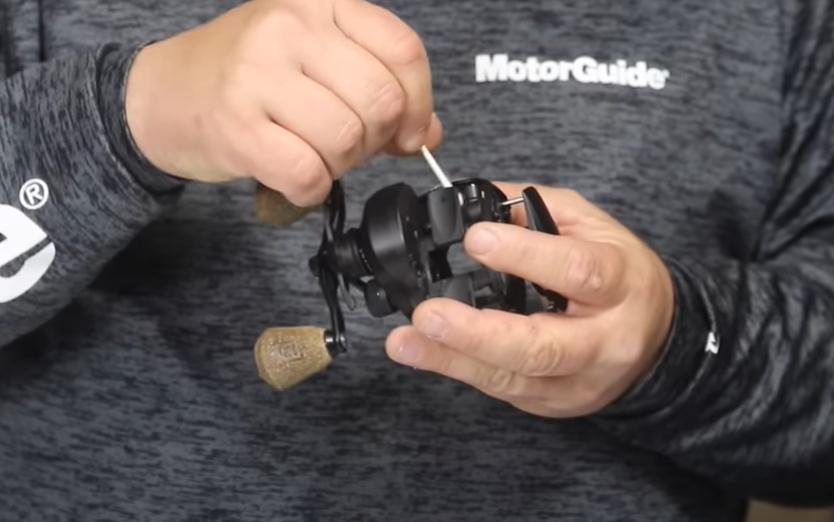
As a piece of precision equipment, a baitcasting reel requires meticulous care. This guide provides step-by-step instructions to keep your reel in top condition, increasing both its effectiveness in landing fish and its overall lifespan. By taking the time to clean and care for your equipment after each fishing trip, you safeguard your investment and Enrich your angling experience. How to Clean a Baitcasting Reel?
Understanding The Components
A pristine baitcasting reel is an angler’s pride and key to a successful outing. But to maintain its performance, one must be adept at the art of cleaning. Nonetheless, before Initiating on this meticulous journey, grasping the anatomy of your baitcasting reel is paramount. This knowledge not only aids in effective maintenance but also prolongs the life of your treasured tool. In this section, we dissect the reel to identify key parts and assemble the essential materials needed for a thorough cleanse. An understanding of each intricate piece ensures your reel remains in peak condition, ready for that next cast.
Identifying The Key Parts Of A Baitcasting Reel
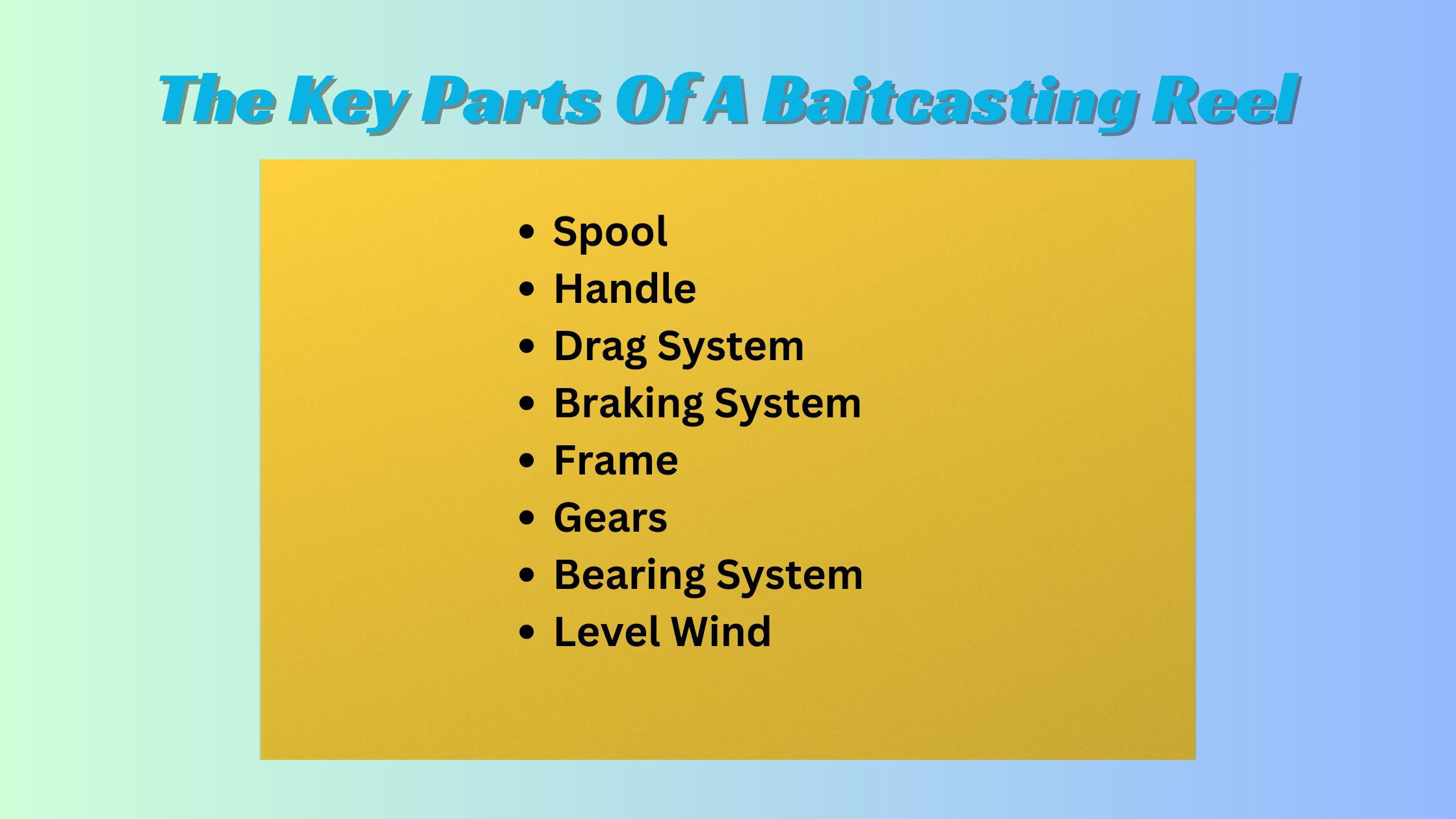
The baitcasting reel, an intricate device, is composed of numerous components that work in harmony. Recognizing these parts is the first step to proficient cleaning:
- Spool: Holds the fishing line and is pivotal for casting and retrieval.
- Handle: Facilitates the winding of the spool to reel in the catch.
- Drag System: Adjustable resistance applied to the spool, critical for battling fish.
- Braking System: Regulates the spool speed during a cast, preventing the dreaded backlash.
- Frame: The skeleton that houses all essential components, providing structure and support.
- Gears: These internal cogs are crucial for the reel’s operation and smoothness.
- Bearing System: Bearings reduce friction, contributing to smooth operation and longevity.
- Level Wind: Guides the line evenly onto the spool, an essential component for line management.
Materials Needed For Cleaning
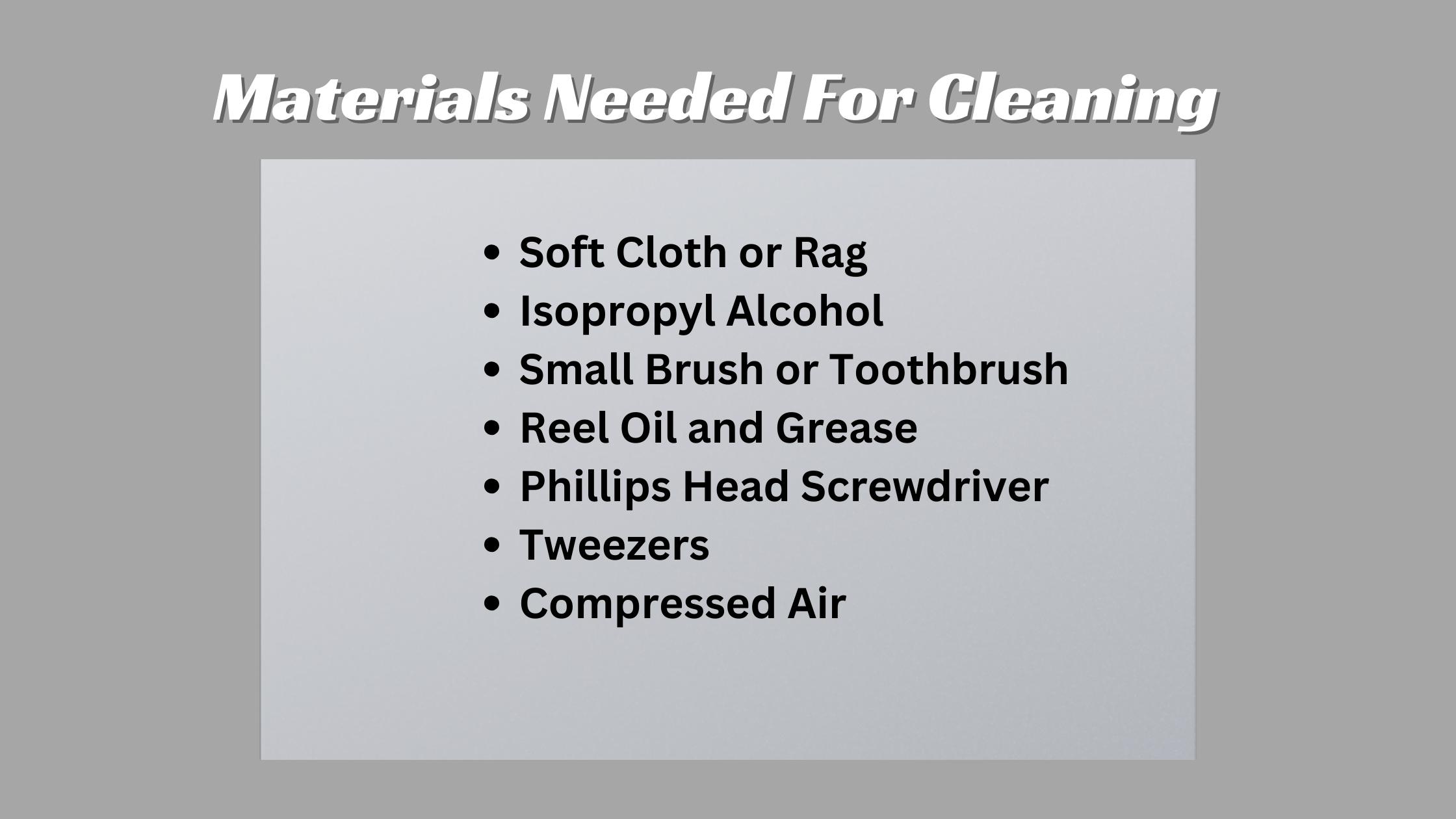
Proper maintenance requires particular tools and solutions. Prepare these items beforehand for a hassle-free cleaning session:
| Material | Use |
|---|---|
| Soft Cloth or Rag: | Wiping away debris and drying components. |
| Isopropyl Alcohol: | Cleansing bearings and dissolving grease. |
| Small Brush or Toothbrush: | Scrubbing hard-to-reach areas. |
| Reel Oil and Grease: | Lubricating moving parts for smooth performance. |
| Phillips Head Screwdriver: | Disassembling the reel for deep cleaning. |
| Tweezers: | Removing and placing small parts or debris. |
| Compressed Air: | Blowing away dirt from tight spaces. |
Remember, a systematic approach starts with precise tools. Keep the aforementioned materials at arm’s reach to ensure your baitcasting reel gets the royal treatment it deserves.
Preparing For Cleaning
Success in maintaining a baitcasting reel hinges on the precision of the cleaning process. Preparing for cleaning is a step that demands attention to detail and a careful approach. Properly preparing your baitcasting reel for cleaning not only extends its lifespan but also Enrich its performance, ensuring that your fishing expeditions are as fruitful as possible. Let us gear up and Submerge into the nitty-gritty of pre-cleaning preparations, beginning with the all-important task of disassembling the reel.
Disassembling The Baitcasting Reel
Disassembling a baitcasting reel is the groundwork for thorough cleaning. Follow these steps to ensure a smooth disassembly:
- Reference the manual: Keep the manufacturer’s guide at hand. Each model is unique and may require specific steps for disassembly.
- Gather your tools: Prepare a clean workspace with the necessary tools, typically small screwdrivers and tweezers, to handle the small parts.
- Remove the reel from the rod: Secure the line before detaching the reel for a clutter-free work area.
- Take pictures: Before proceeding, take pictures of the reel assembly to aid in reassembling the parts correctly.
- Start with the spool: Gently remove the spool, as it’s the first piece to come out in most baitcasting reels.
- Keep parts organized: As you carefully remove each part, place them in an organized fashion to ensure an effortless reassembly process.
Keep in mind to handle all components with care to prevent any accidental damage or loss.
Inspecting For Damage Or Wear
With the baitcasting reel disassembled, a critical inspection is due. Look for any signs of damage or wear that could compromise the reel’s efficiency:
- Check the spool: Examine the spool for nicks or warps that could impact the line’s flow.
- Inspect gears: Gears should be smooth without any stripped teeth or rust.
- Examine bearings: Bearings are pivotal for smooth operation. Rotate them to ensure they run freely
- Observe the frame: The frame should be free from cracks and significant signs of stress.
- Evaluate the handle: The handle should move fluidly without resistance.
Identify any worn-out parts needing replacement to guarantee optimal performance after the cleaning process.
Cleaning The Baitcasting Reel
Cleaning your baitcasting reel regularly not only maintains its performance but also extends its lifespan, ensuring that you get the most out of your investment. Anglers know that a clean reel can mean the difference between a good day of fishing and a frustrating one. With the right approach, cleaning a baitcasting reel becomes a simple task that can prevent wear and tear and save you money in the long run. Let’s Submerge into the key steps:
Cleaning The Exterior And Handles
Start with the outer shell of your baitcasting reel. A soft cloth dipped in soapy water is your best friend here. Gently wipe down the exterior to remove any dirt or salt buildup. Pay special attention to the handles as they often harbor grime from repeated use. A toothbrush can get into the nooks and clean thoroughly without damaging the components. Once clean, dry the exterior with a soft, lint-free cloth to prevent rust and corrosion.
Lubricating The Gears And Bearings
Proper lubrication is critical for smooth operation. Begin by disassembling the reel according to the manufacturer’s instructions. Use a cotton swab or a soft brush to apply reel oil to the gears. For the bearings, a high-quality reel grease works best to ensure fluid motion and protect against wear. Apply sparingly; over-lubrication can attract more dirt and hinder performance. Reassemble the reel, making sure every part moves freely.
Removing Corrosion And Grime From The Interior
The interior of a baitcasting reel can accumulate debris and develop corrosion over time. Disassemble the reel, taking care to organize the parts for easy reassembly. Using a mild solvent, clean the internal parts with a soft brush to remove any oxidation or build-up. Stubborn spots may require a little extra elbow grease or a specialized cleaner designed for fishing gear. Rinse off any cleaning agents with fresh water, dry completely, and then reassemble. This step ensures the longevity and performance of your reel, making it ready for your next fishing adventure.
Reassembling And Maintenance
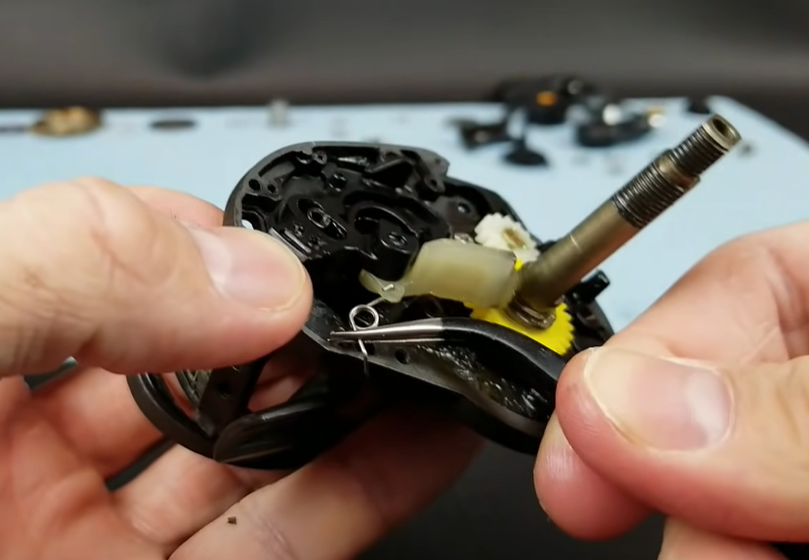
Once your baitcasting reel is cleaned and its parts laid out before you, it’s time to reassemble it with care, ensuring that every component is in perfect harmony for optimal performance on your next fishing trip. Keeping your reel well-maintained goes a long way in extending its life and enhancing your angling experiences. Let’s Submerge into the meticulous process of putting the pieces back together and discuss the best practices for storing and maintaining your baitcasting reel.
Reassembling The Baitcasting Reel
- Start by greasing the gears. Apply a thin layer of reel grease to the main gear and pinion gear.
- Reinsert the spool. Make sure it sits evenly on the reel frame.
- Place the bearings back into their original positions and lightly oil them.
- Attach the side plate,
ensuring it clicks into place without force. - Reattach the handle and drag system. Confirm they move smoothly without resistance.
- Test the reel’s functions. Before finalizing, perform a quick check to ensure everything is working cohesively.
Proper Storage And Maintenance Techniques
- Store your reel in a cool, dry place. Extreme temperatures and moisture can damage the reel over time.
- Use a reel cover to protect it from dust and scratches.
- Regularly check for loose screws and parts,
tightening them as necessary. - After each use, give the reel a quick clean. Wipe away any dirt and saltwater with a soft cloth.
- Lubricate your reel with an oil designed for baitcasting reels after cleaning for optimal performance.
Testing And Troubleshooting

Maintaining the smooth and efficient operation of a baitcasting reel is essential for any dedicated angler. After cleaning your baitcasting reel, the next crucial steps are Testing and Troubleshooting. These crucial processes will help you ensure that your reel performs at its best and identify any issues that cleaning alone may not have resolved. Here’s how to meticulously test your reel’s performance and troubleshoot common problems that may arise.
Testing The Reel’s Performance
Testing your baitcasting reel after a thorough cleaning ensures it operates smoothly. To begin, follow these simple checks:
- Spool Spin Test: Start with the spool spin test. Engage the reel and give the spool a gentle spin. It should move freely without any interruptions.
- Brake System Check: Adjust the brake system and cast. The settings should vary the casting distance as expected, without overruns.
- Drag Force: Examine the drag system by applying tension to the line. The drag should be smooth and consistent.
- Handle Movement: The handle should turn effortlessly with no unusual resistance or noise.
If any components fail these tests, it’s a signal that further investigation and potentially more intricate maintenance tasks are required.
Troubleshooting Common Issues
Encountering snags with your baitcasting reel can be frustrating. Troubleshooting common issues helps isolate and fix problems swiftly. Here are some typical problems and their likely solutions:
- Noise or Resistance: Persistent grating sounds or resistance often mean residual debris or a need for additional lubricant. Re-examine and cleanse the gear system, then apply fresh lubricant judiciously.
- Brake Problems: If the brakes seem unresponsive, ensure the brake system is properly configured and clean any parts that may be causing drag.
- Drag Sticking: For a sticky drag system, disassemble the drag mechanism. Clean and lubricate the drag washers, ensuring they are not worn out. A replacement may be necessary if wear is evident.
- Spool Issues: Trouble with the spool, such as wobbling or not spinning, could stem from a misaligned spool or worn bearings. Check for proper alignment and consider replacing the bearings if they show signs of deterioration.
| Problem | Possible Cause | Solution |
|---|---|---|
| Reel feels stiff | Insufficient lubrication or debris build-up | Apply quality lubricant / Clean thoroughly |
| Line is not casting smoothly | Brake system misalignment or spool tension issues | Adjust brake system / Check spool tension |
| Unusual noise during reel operation | Loose parts or lack of lubrication | Tighten parts / Lubricate moving components |
Through diligent testing and troubleshooting, you can anticipate peak reel performance and a more enjoyable fishing experience. Ensure all parts are operating correctly and tackle any issues immediately for the best results.
Frequently Asked Questions For How To Clean A Baitcasting Reel
What Is The Best Way To Clean A Baitcasting Reel?
Keeping your baitcasting reel in top condition is vital for smooth casts and long-lasting performance. Cleaning it regularly ensures its longevity and functionality. Start by removing the side plate, giving you access to the internal components. This step is pivotal for a thorough cleaning. Choosing the best solvent for cleaning fishing reels is crucial. Opt for a solvent that effectively dissolves grime without damaging the reel’s components. Carefully wipe down the reel components, focusing on areas like under the cast control knob.
A meticulous cleaning ensures the removal of debris and salt residue, especially after saltwater fishing. Lubricate the bearings with an appropriate oil and re-grease the baitcaster, ensuring smooth operation and preventing corrosion. Reinstall the cast control knob and reassemble the reel. Double-check for proper alignment and functionality before concluding the process.
How Often Should You Maintain Your Baitcasting Reel?
For optimal performance, maintain your baitcasting reel every 2-3 uses or after exposure to harsh conditions, like saltwater or sand. Regular maintenance prolongs your reel’s lifespan and ensures smooth operation.
Can I Use Wd40 On My Baitcasting Reel?
WD40 is not recommended for baitcasting reels as it can remove essential lubricants. Instead, use products specifically designed for lubricating fishing reels to protect the components effectively and keep the reel functioning properly.
What Tools Do I Need To Clean My Baitcasting Reel?
You’ll need a set of screwdrivers to disassemble the reel, a soft brush or toothbrush for debris removal, and professional reel oil and grease for proper lubrication. Keep a clean cloth on hand for wiping down parts.
Conclusion
Maintaining your baitcasting reel couldn’t be simpler with these steps. Regular cleaning ensures peak performance and extends the life of your equipment. Remember, a well-cared-for reel can be the difference between a good fishing trip and a great one. Now, go enjoy a smooth cast on your next outing!

